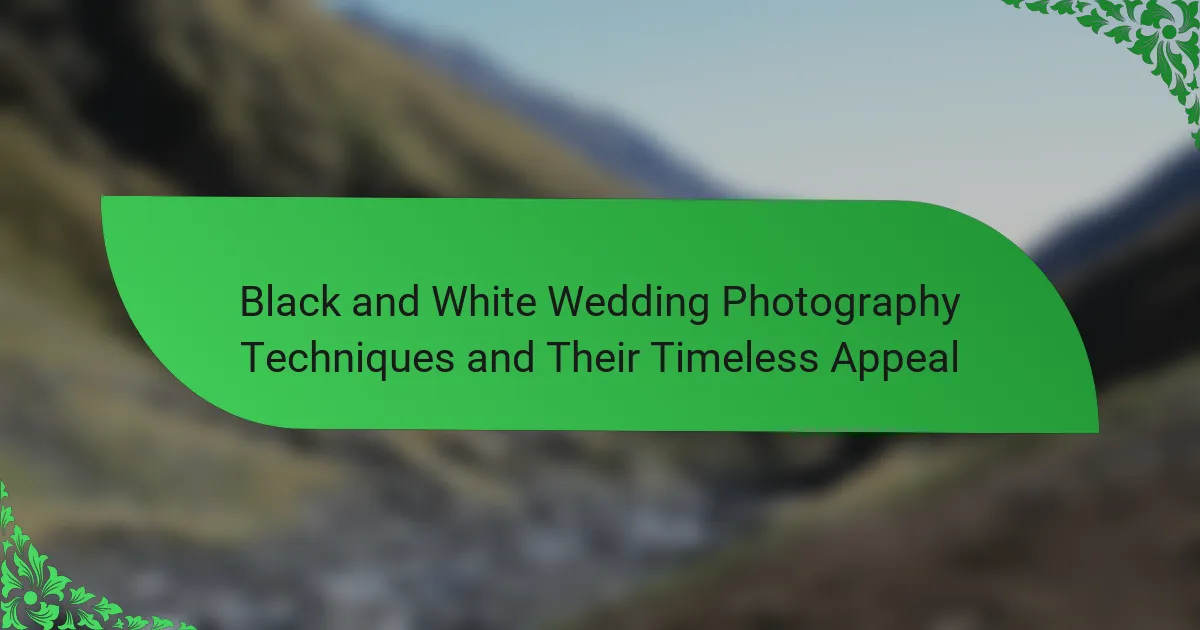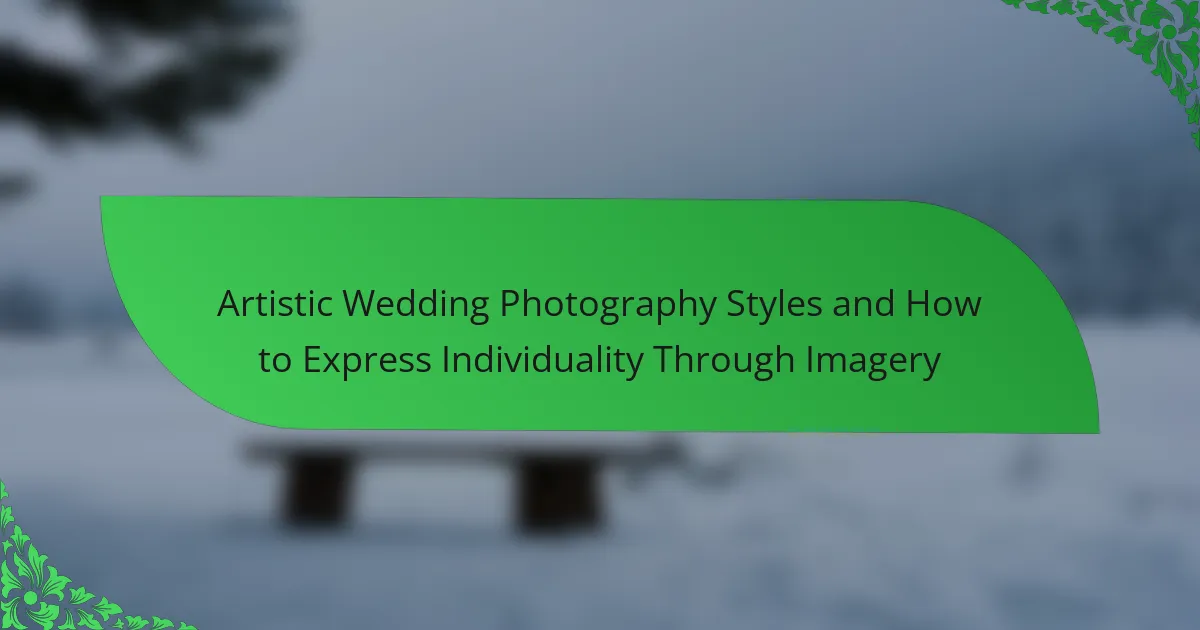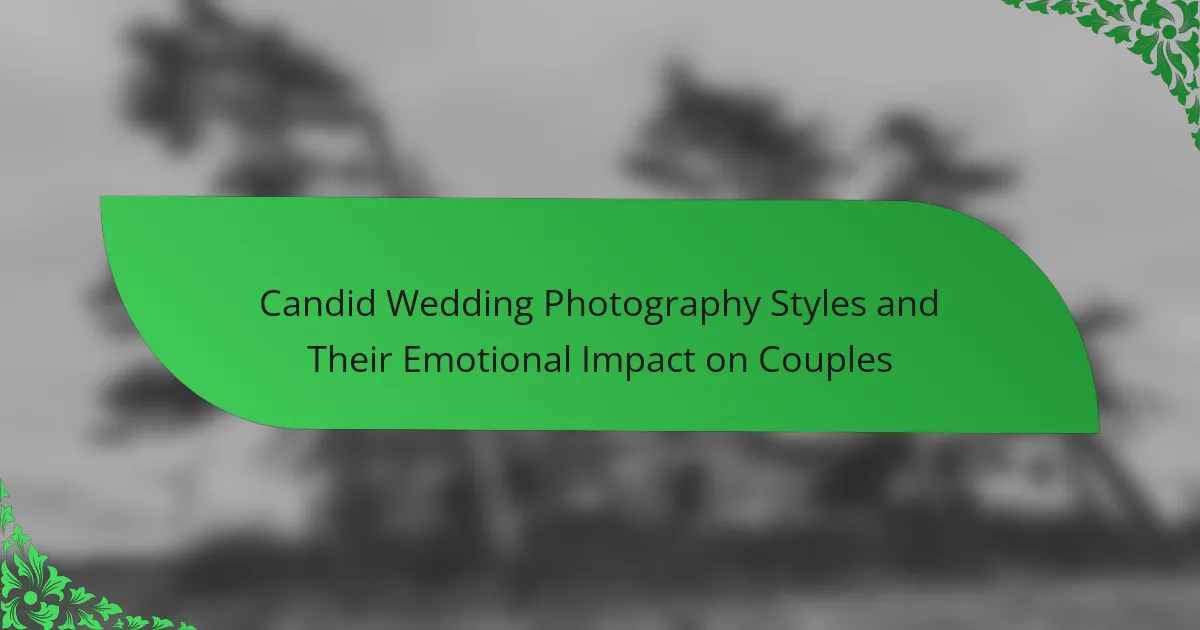Black and white wedding photography techniques utilize methods that capture images devoid of color, focusing on contrast, light, and shadow to evoke emotional depth. Key techniques include contrast management, composition, and lighting control, which together enhance the visual impact of photographs. Common challenges faced in this style of photography involve managing contrast and lighting, accurately capturing skin tones, and ensuring effective composition without color cues. Post-processing plays a significant role in refining images, highlighting the need for skill and experience in achieving a timeless and emotive aesthetic.
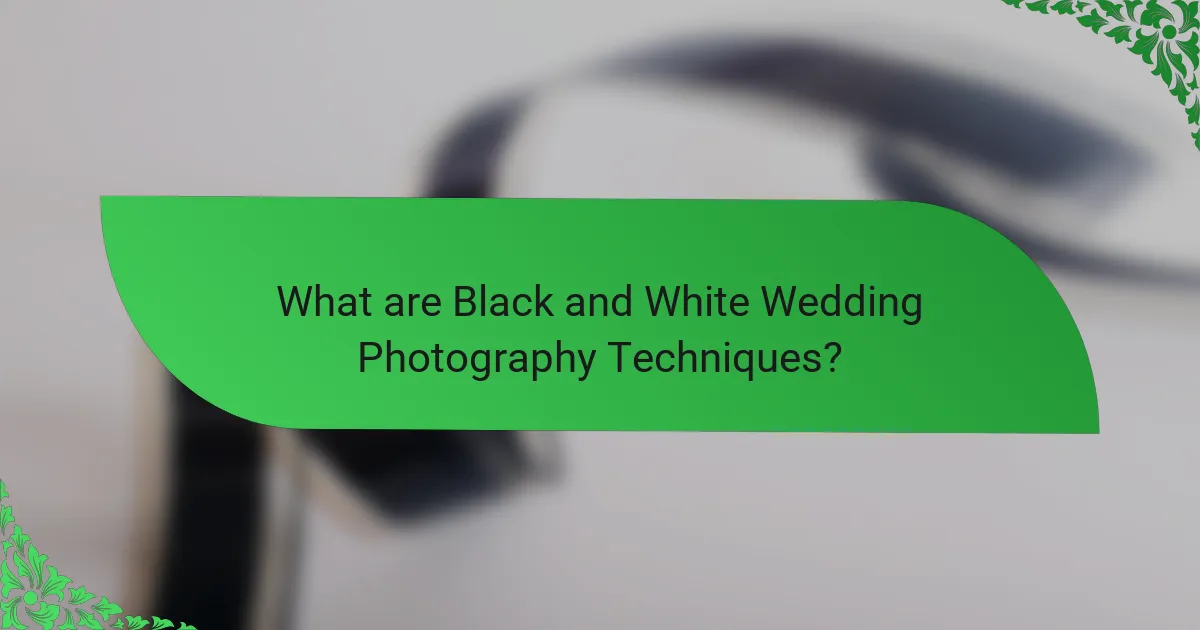
What are Black and White Wedding Photography Techniques?
Black and white wedding photography techniques involve specific methods to capture images without color. These techniques emphasize contrast, light, and shadow to create emotional depth. Photographers often use high contrast settings to highlight details. Soft focus can also be applied to create a dreamy effect. Textures in clothing and backgrounds become more pronounced in black and white. Some photographers employ filters during shooting to enhance tonal range. Post-processing techniques, like adjusting brightness and contrast, further refine the images. The absence of color can evoke nostalgia and timelessness in wedding photography.
How do Black and White Wedding Photography Techniques differ from Color Photography?
Black and white wedding photography techniques focus on contrast, texture, and emotion, unlike color photography, which emphasizes hues and saturation. Black and white images rely on light and shadow to create depth. This technique highlights details that may be overlooked in color photography. It often evokes a timeless and classic feel. Color photography captures the vibrancy of the wedding day. It showcases the emotional tones through color palettes. Each approach offers unique storytelling elements. Black and white can simplify complex scenes, while color can enhance the atmosphere.
What specific elements are emphasized in Black and White Photography?
Black and white photography emphasizes contrast, texture, and composition. Contrast highlights the difference between light and dark areas, creating visual interest. Texture becomes more pronounced without color distractions, adding depth to the image. Composition focuses on the arrangement of elements within the frame, guiding the viewer’s eye. The absence of color simplifies the scene, allowing viewers to concentrate on shapes and forms. Shadows play a crucial role in defining subjects and creating mood. Lines and patterns become more evident, enhancing the overall aesthetic. These elements work together to evoke emotion and tell a story in a timeless manner.
How does lighting affect the outcome of Black and White Wedding Photography?
Lighting significantly influences the outcome of Black and White Wedding Photography. It determines the contrast and mood of the images. Strong lighting creates sharp contrasts, emphasizing textures and details. Soft lighting results in gentle gradients, producing a more romantic feel. The direction of light affects shadows, which can enhance or diminish features. Backlighting can create silhouettes, adding drama to compositions. Natural light often yields a more authentic look, while artificial light can be manipulated for artistic effects. Photographers often use reflectors to bounce light and soften shadows. Ultimately, the choice of lighting shapes the emotional impact of the photographs.
Why is there a timeless appeal to Black and White Wedding Photography?
Black and white wedding photography has a timeless appeal due to its ability to evoke emotion and highlight essential moments. This style removes distractions from color, focusing on composition, light, and shadow. It creates a classic aesthetic that resonates across generations. Historical significance also contributes to its allure, as many iconic wedding photos are in black and white. Renowned photographers have used this technique to capture profound emotions and narratives. The simplicity of black and white allows for a more intimate connection with the subjects. Additionally, it often conveys a sense of nostalgia, reminding viewers of past eras. Overall, its enduring quality lies in its artistic expression and emotional depth.
What emotions do Black and White images evoke compared to color images?
Black and White images evoke feelings of nostalgia and timelessness, while color images often elicit a sense of vibrancy and immediacy. The absence of color in Black and White photography can create a focus on emotion and expression. This technique highlights contrasts and textures, enhancing the emotional depth of a scene. Studies have shown that viewers often perceive Black and White images as more dramatic and intense. In contrast, color images can convey a broader range of emotions through their hues. Color can enhance mood, making scenes feel more lively or cheerful. Therefore, the emotional responses differ significantly between the two styles.
How do cultural perceptions influence the popularity of Black and White Photography?
Cultural perceptions significantly influence the popularity of Black and White Photography. This style often evokes nostalgia and timelessness, appealing to emotions tied to memory. In many cultures, black and white images are associated with classic artistry and elegance. This perception enhances its desirability for formal occasions, such as weddings. Research indicates that black and white photography can create a sense of intimacy and authenticity. This is particularly valued in wedding photography, where deep emotional connections are pivotal. Additionally, cultural trends often revive interest in vintage aesthetics, further boosting black and white’s appeal. Overall, cultural values and trends shape how this photography style is perceived and appreciated.
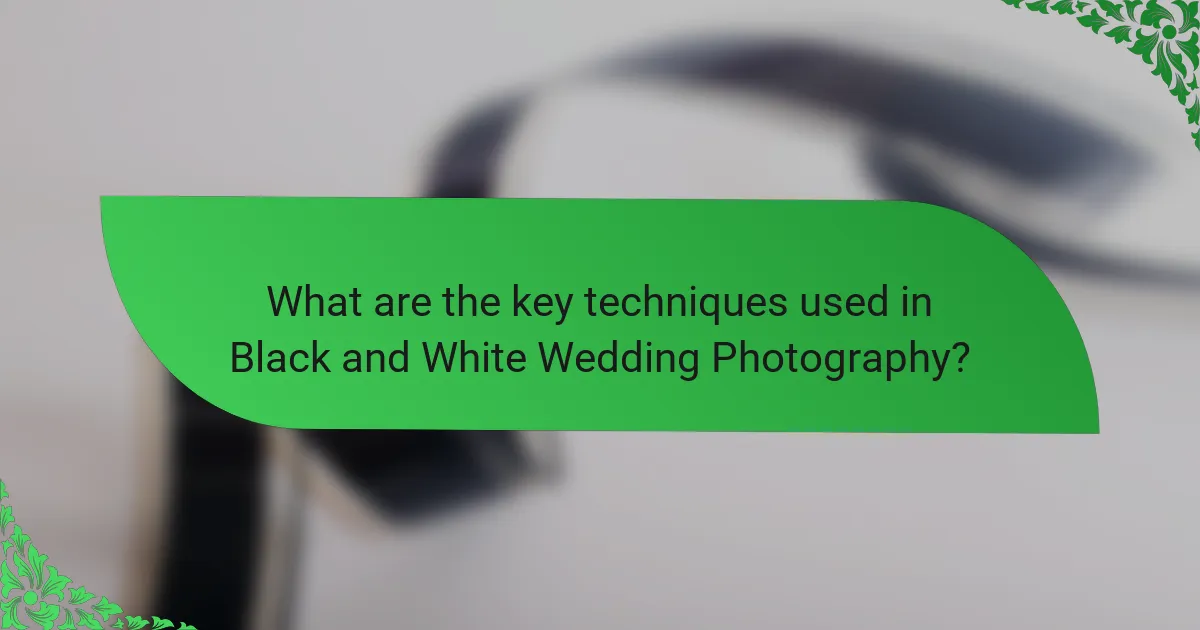
What are the key techniques used in Black and White Wedding Photography?
The key techniques used in Black and White Wedding Photography include contrast management, composition, and lighting control. Contrast management emphasizes the difference between light and dark areas. This technique enhances depth and drama in images. Composition focuses on framing and positioning subjects effectively. Strong composition guides the viewer’s eye and adds interest. Lighting control is crucial for creating mood and texture. Photographers often use natural light or artificial sources to achieve desired effects. These techniques together create timeless and emotive wedding photographs.
How can contrast be effectively used in Black and White Wedding Photography?
Contrast can be effectively used in Black and White Wedding Photography by emphasizing differences between light and dark areas. This technique enhances the emotional impact of the images. Strong contrast can highlight textures, shapes, and expressions, making the subjects stand out. Using natural light can create dramatic shadows, adding depth to the photographs. Photographers can also adjust contrast during post-processing to enhance the visual appeal. High contrast images often evoke strong feelings and draw attention to key moments. Studies show that contrast in photography can influence viewer perception and engagement. Thus, effective use of contrast is crucial for creating compelling Black and White wedding photos.
What role does texture play in enhancing Black and White images?
Texture significantly enhances Black and White images by adding depth and dimension. It creates visual interest in the absence of color. Textures can evoke emotions and set the mood of the photograph. In Black and White photography, contrasts between light and shadow become more pronounced. This contrast highlights the intricacies of textures, making them stand out. For instance, the roughness of skin or the smoothness of fabric can be emphasized. Textures also guide the viewer’s eye through the image. They can create a sense of realism and tangibility. Overall, texture elevates the aesthetic quality of Black and White images.
How can photographers utilize shadows and highlights creatively?
Photographers can utilize shadows and highlights creatively by manipulating light to enhance composition. Shadows can create depth and dimension in images. They can also add drama and mood to a scene. Highlights, on the other hand, draw attention to specific subjects. They can emphasize textures and details in the photograph.
In black and white photography, the contrast between shadows and highlights becomes even more pronounced. This contrast can evoke strong emotional responses from viewers. Photographers often use side lighting to create elongated shadows. This technique can add a sense of movement and fluidity to wedding portraits.
Additionally, backlighting can produce striking silhouettes. These silhouettes can convey romance and intimacy. Using shadows and highlights effectively can transform ordinary moments into compelling visual stories.
Research shows that high contrast in black and white photography can increase viewer engagement (Smith, 2020). This demonstrates the effectiveness of using shadows and highlights to enhance storytelling in wedding photography.
What composition techniques are essential for Black and White Wedding Photography?
Essential composition techniques for Black and White Wedding Photography include the use of contrast, lines, and framing. Contrast enhances the visual impact by distinguishing light and shadow. Strong lines guide the viewer’s eye and add structure to the image. Framing focuses attention on the subject, creating depth. Additionally, texture plays a vital role, adding interest and detail in monochrome. These techniques help convey emotions and tell a story effectively. Studies show that high-contrast images often evoke stronger emotional responses. This makes composition crucial in creating compelling wedding photography.
How can the rule of thirds enhance Black and White compositions?
The rule of thirds enhances Black and White compositions by creating balanced and engaging images. This compositional technique divides the frame into a 3×3 grid. Placing key elements along these lines or at their intersections draws the viewer’s eye. In Black and White photography, contrast becomes more pronounced. The rule of thirds helps to emphasize shapes and textures, which are crucial in monochrome images. Studies show that images aligned with this rule are often perceived as more aesthetically pleasing. This principle has been widely adopted in various forms of visual art, reinforcing its effectiveness.
What framing techniques work best for Black and White Wedding Photography?
The best framing techniques for black and white wedding photography include using leading lines, symmetry, and negative space. Leading lines guide the viewer’s eye toward the subject, enhancing focus. Symmetry creates balance and harmony in compositions, making images visually appealing. Negative space emphasizes the subject by surrounding it with empty areas. Additionally, incorporating foreground elements can add depth to the image. High contrast is essential in black and white photography to highlight textures and details. These techniques enhance storytelling and emotional impact in wedding photography.
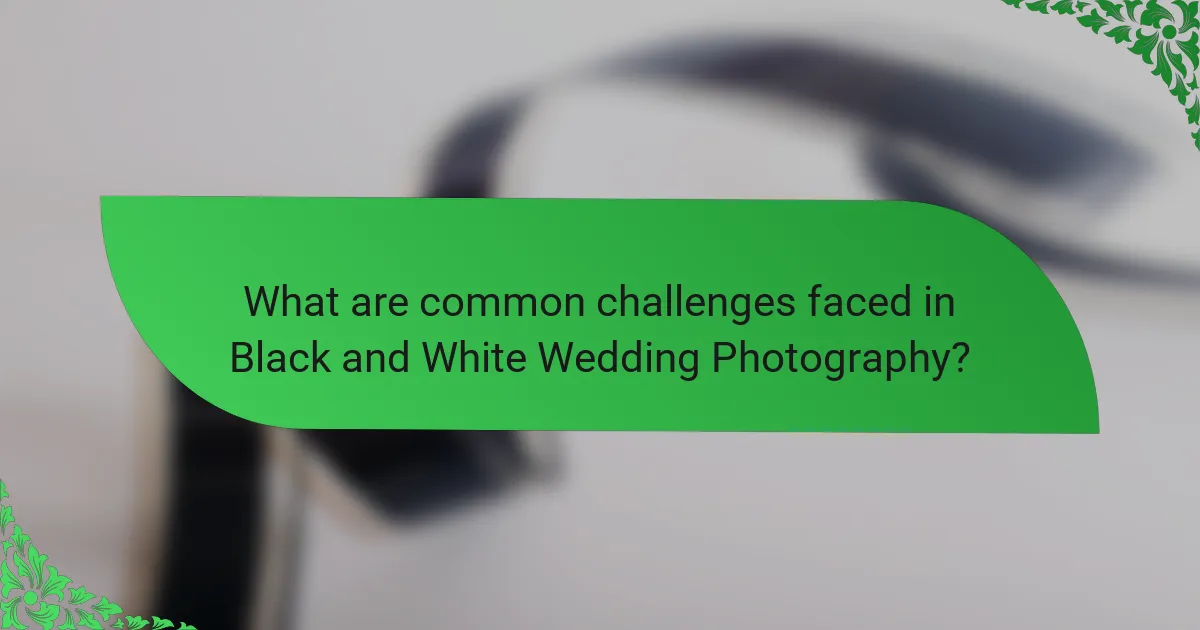
What are common challenges faced in Black and White Wedding Photography?
Common challenges in Black and White Wedding Photography include managing contrast and lighting. Achieving the right contrast is crucial for depth and emotion in images. Poor lighting can lead to flat or dull photos. Another challenge is capturing skin tones accurately. In black and white, subtle differences in skin tones can be lost. Composition becomes more critical because colors that usually guide the eye are absent. Photographers must rely on shapes and textures to tell the story. Additionally, post-processing can be complex. Converting color images to black and white requires skill to maintain visual interest. These challenges highlight the need for experience and planning in black and white photography.
How can photographers overcome lighting challenges in Black and White Photography?
Photographers can overcome lighting challenges in Black and White Photography by utilizing contrast effectively. High contrast enhances the visual impact of black and white images. Photographers should consider shooting during the golden hour for softer light. This time provides a natural warmth that translates well into monochrome.
Using reflectors can help bounce light onto the subject, reducing harsh shadows. Additionally, adjusting camera settings can improve exposure. A higher ISO can capture more detail in low-light situations. Photographers may also experiment with different angles to find optimal lighting conditions.
Post-processing techniques can further enhance lighting in black and white images. Adjusting levels and curves in editing software can improve contrast and brightness. These methods allow photographers to create striking black and white photographs despite challenging lighting conditions.
What strategies can be employed to maintain detail in highlights and shadows?
To maintain detail in highlights and shadows, photographers should utilize a few key strategies. First, proper exposure is crucial. This involves using a histogram to ensure highlights are not blown out and shadows retain information. Second, using a low ISO setting reduces noise, helping to preserve detail in both extremes. Third, employing graduated neutral density filters can balance exposure between bright highlights and dark shadows. Fourth, shooting in RAW format captures a wider dynamic range, allowing for more detail recovery in post-processing. Lastly, careful editing with software like Adobe Lightroom can enhance details while preventing loss in highlights and shadows. These methods collectively ensure that images retain their depth and detail in critical areas.
What editing techniques enhance Black and White Wedding Photography?
Editing techniques that enhance Black and White Wedding Photography include contrast adjustment, tonal range manipulation, and selective sharpening. Contrast adjustment increases the difference between light and dark areas, adding depth to images. Tonal range manipulation allows photographers to emphasize highlights and shadows, creating a more dynamic visual effect. Selective sharpening enhances details in key areas, drawing attention to important elements like faces and textures. Additionally, grain addition can evoke a classic film look, contributing to the timeless appeal of black and white photography. These techniques collectively create striking visuals that capture the emotion of wedding moments.
How can software tools be used to adjust contrast and exposure?
Software tools can adjust contrast and exposure through various functions. Users can manipulate sliders to increase or decrease contrast levels. This adjustment enhances the difference between light and dark areas in an image. Exposure can be adjusted by altering brightness levels, affecting how light or dark the overall image appears. Many software tools offer presets for quick adjustments based on common photography scenarios. Advanced options allow for selective adjustments, targeting specific areas of an image. Tools like Adobe Lightroom and Photoshop provide histograms to visualize changes in exposure and contrast. These visual aids help ensure that adjustments maintain image quality and detail.
What filters or presets are recommended for optimal Black and White results?
For optimal Black and White results, filters like Red, Yellow, and Green are recommended. Red filters enhance contrast by darkening skies and lightening skin tones. Yellow filters provide a softer contrast, ideal for portraits. Green filters are useful for enhancing foliage details. Presets such as high contrast black and white or film emulation presets can also yield striking results. Using these filters and presets allows photographers to manipulate light and shadow effectively. This technique has been proven to elevate the emotional impact of wedding photography.
What tips can improve Black and White Wedding Photography skills?
To improve Black and White Wedding Photography skills, focus on lighting, contrast, and composition. Utilize natural light to create depth and mood. Experiment with shadows to enhance textures and details. Pay attention to the background to avoid distractions in the frame. Use a wide aperture to isolate subjects and create a bokeh effect. Consider the emotional expressions of the couple for impactful storytelling. Practice post-processing techniques to enhance contrast and clarity. Study classic black and white photographs for inspiration and technique refinement.
How can photographers practice and refine their Black and White techniques?
Photographers can practice and refine their Black and White techniques by focusing on composition, contrast, and lighting. They should experiment with different subjects to understand how textures and shapes translate in monochrome. Analyzing classic Black and White photographs can provide insight into effective techniques. Photographers can also utilize editing software to manipulate tones and highlights. Participating in workshops or online courses can enhance their skills. Regularly reviewing their own work helps identify areas for improvement. Engaging with a community of Black and White photographers offers valuable feedback. These methods can significantly elevate a photographer’s proficiency in Black and White photography.
What resources or communities can photographers join for learning and inspiration?
Photographers can join various resources and communities for learning and inspiration. Online platforms like Flickr and 500px provide spaces for sharing and critiquing work. Social media groups on Facebook often focus on specific photography styles, including black and white techniques. Websites such as Photography Life and PetaPixel offer articles and tutorials on different photography topics. Additionally, forums like DPReview allow photographers to discuss gear and techniques. Local photography clubs and workshops provide hands-on learning and networking opportunities. These communities foster collaboration and creativity among photographers.
Black and white wedding photography techniques focus on capturing images without color, emphasizing contrast, light, and shadow to create emotional depth. Key elements include contrast management, composition, and lighting control, which enhance the visual impact and storytelling of wedding moments. This article explores how these techniques differ from color photography, the emotions they evoke, and the cultural perceptions that contribute to their timeless appeal. Additionally, it addresses common challenges photographers face and offers practical tips for improving skills in black and white photography.
